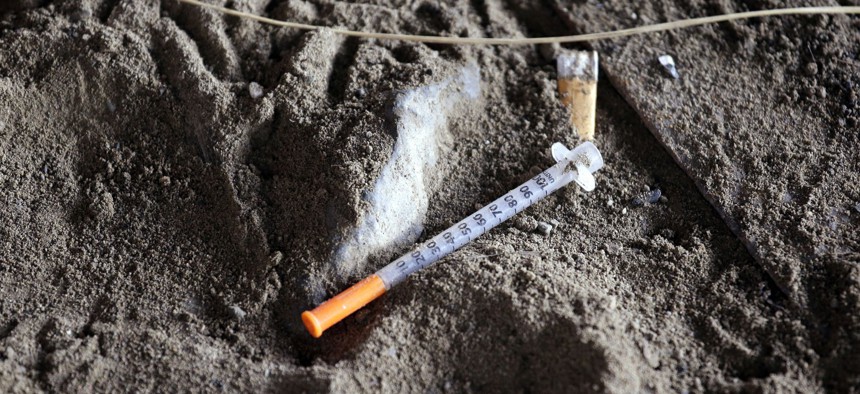An Elephant Tranquilizer Is the Newest Terrifying Twist in the Opioid Crisis

a discarded syringe sits in the dirt with other debris under a highway overpass. Elaine Thompson / AP File Photo
Mere micrograms—the equivalent of a few grains of sugar—can be fatal.
Part of what makes the opioid epidemic such a wicked problem is the speed with which the entire epidemic can change. Blink, and you could have a brand new crisis on your hands.
The spread of carfentanil is the latest development. The substance itself is a terrifyingly powerful big animal sedative that is being mixed with heroin to fatal results. And, over the course of the last several weeks, police departments across the country have issued alerts that the drug has landed on their doorstep.
On Tuesday, three cases of carfentanil-related overdoses were confirmed in New Hampshire. The drug has been linked to two recent deaths in Anne Arundel County, Maryland, and one in Frederick County, Maryland. Coroners in Illinois, Wisconsin, Minnesota and Colorado have all confirmed that carfentanil was involved in deaths within the past several weeks.
While these deaths are tragic, it should be noted these overdoses fit into the larger trend of the opioid crisis. As Route Fifty has reported previously, national-level data from the U.S. Centers for Disease Control and Prevention have found that overdose deaths as a result of so-called “natural” drugs like heroin and “semi-synthetic” opioids like oxycodone and hydrocodone are actually on the decline, while deaths from synthetics like fentanyl and carfentanil are rising in number. In 2010, 8 percent of overdose deaths in the U.S. were linked to synthetic overdoses, by 2015, it had risen to 18 percent.
So, what makes carfentanil so dangerous?
The drug, which comes to the country from labs in China, is incredibly potent. By some accounts, it’s more than 100 times more potent than fentanyl—which is already more than 100 times stronger than heroin. Mere micrograms—the equivalent of a few grains of sugar—can be fatal.
While fentanyl was developed to be used in treatment of humans—some drug companies even produce it in lollipop form as a pain management tool for patients undergoing chemotherapy—carfentanil was never intended to be used by people. Rather, it’s a drug that was strictly meant as a tranquilizer for elephants, rhinos, hippos and other big game.
In fact, carfentanil is so potent, all the zookeepers and vets in the U.S. combined only need about 18 grams of the drug for an entire year—that’s less than roughly 5 teaspoons, Melvin Patterson, a spokesman for the Drug Enforcement Administration told The Washington Post.
To the naked eye, heroin and heroin that has been cut with carfentanil look exactly the same, making it impossible for drug users to know for sure exactly what it is they are putting in their bodies.
And, finally, carfentanil can be ingested if it is absorbed into bare skin or inhaled, meaning it poses a unique threat to first responders, medical personnel and coroners. If inhaled or touched, even a puff of powder that escapes out of a bag as it’s resealed, could be toxic.
In response, police departments across the country have issued special alerts to emergency medical personnel to take extra precautions when dealing with overdose victims. And, due to the risks associated with handling carfentanil, many law enforcement agencies are choosing to suspend testing of heroin at crime scenes, saving those procedures for the safety of a laboratory instead.
And, to make matters even more complicated, someone overdosing on carfentanil may require more than just the standard single dose of Narcan, the overdose-reversing drug. In short, Lakshmi K. Sammarco, the coroner for Hamilton County, Ohio, put it this way to The Denver Post last year: “Don’t count on Narcan to be able to reverse the effects of carfentanil.”
Anecdotally, first responders in the field have reported that it that it can take as many as six doses of Narcan to reverse a carfentanil overdose.
And, following the tragedy of a carfentanil overdose death, the complications aren’t over. Carfentanil presents several particular hurdles for medical examiners and coroners. First, because the lethal amount of the drug is so miniscule, it can be incredibly difficult to detect in a toxicology screening.
And, in order to do that screening in the first place, coroners must have on hand a clean sample of the drug—in order to know what to look for. But, because carfentanil is so new, many companies that would otherwise supply the sample, often called a “known standard” don’t have them.
Quinn Libson is a Staff Correspondent for Government Executive’s Route Fifty based in Washington, D.C.
NEXT STORY: Disconnected Youth: Out of School And Out of Work in Rural America






